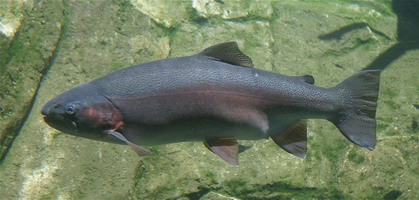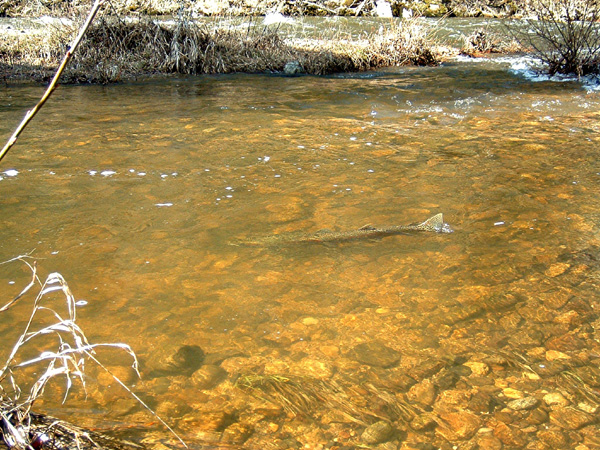The Kilarc Project
An Initial Plan
At present, July 2007, PG&E has submitted, and had accepted, a schedule to surrender its hydroelectric license number 606 to the Federal Energy Regulatory Commission. We understand that for PG&E to be relieved of its responsibilities, PG&E's plan is to decommission the project features that it has operated and maintained.
The balance between environment and power production has changed since the project was licensed, so that PG&E has concluded that it will choose not to continue operation of the powerhouses and to dispose of the project in accordance with the required NEPA and CEQA procedures. For each of the facilities - the Old Cow and the South Cow, there are several basic choices for each project feature: Abandon it in place, change it to improve the environmental conditions it has changed, or in the extreme, remove it modifying the site to some standard acceptable to the "4-E" agencies. The process, as defined by the FERC, is identical to a licensing process.
• In Licensing, the construction of a project is evaluated as a balance between environmental and power goals, with certain of the agencies having over-riding "4-E" authority to impose any conditions they desire.
• In License surrender - here called by PG&E, Decommissioning, the choice is to abandon the project facilities leaving the facilities as they are, vis-a-vis the alternative of removing some or all of the project facilities.
The choice has to be driven by the same considerations that would be used in licensing the same facilities. To address this process asks whether the facilities could be operated differently so that they would enhance the fish habitat in the area. To that end, Davis Hydro has created a new company to recommission the facilities, if it turns out that a way can be found to operate the facilities in an environmentally friendly manner.
To address this objective, it may be necessary to abandon part of the generation at the South Cow powerhouse and associated project development and rebuild the South Cow as a major fish habitat for anadromous fish. Perhaps the old South Cow diversion channel could be buried and operated in a manner to meet the following objectives:
- Water for the Abbott Ditch, they have had a de facto diversion at the current PG&E hydropower diversion dam for the past 103 years.
- Water for German Ditch water right holders.
- Fish enhancements along the whole South Cow to meet NMFS and CDFG objectives.
Perhaps the Old Cow could be evaluated as a source for the following:
- Cold water delivered from cold areas high on the mountain to downstream spawning and juvenile habitat areas.
- Rainbow trout fishing on whole diversion.
- Handicapped fishing access.
We understand that the restoration of the fish habitat must benefit steelhead and salmon (anadromous fish that migrate to-from the ocean). This is the primary goal of the National Marine Fisheries Service, a goal shared by the California Department of Fish and Game along with their mission of providing recreational fish (trout) resources based primarily on the rainbow trout that do not migrate to the sea. To confuse this issue, the steelhead are the same fish genetically as the rainbow trout that are seeded in the area for recreational fishing.
KC LLC proposes to operate the Kilarc/Old Cow forebay part of the project much as it is today. In order to do that we want to put together a plan that protects and enhances the fish habitat better than the plan of removal. Likewise we might operate the South Cow powerhouse in a reduced capacity that does not interfere with fish spawning in the river to meet the Abbott ditch diversion requirements. To do this, we will work with local land owners to improve the habitat to offset any negative impact of the hydropower bypass on the fish populations.
Focus on the Fish
We are seeking ideas, from all people in the whole of the Cow Creek watershed and in particular individuals along the South and Old Cow Creeks, on what are the best ways to pursue necessary fishery enhancement while respecting human interests in the bordering lands, ditches, and water flows in general.
Discussion might consider the following points:
- There is limited habitat above the powerhouse on Old Cow as the stream rapidly runs into a narrow V-gorge valley beyond the bridge. There is also a physical fish barrier upstream of the bridge, and no public access.
- There is, or could be, extensive habitat on the South Cow, especially if developed in cooperation with the bordering ranchers and water users.
- The Kilarc diversion releases very cold water into the Cow Creek system through the powerhouse thereby helping the downstream water and habitat conditions.
- The Kilarc Reservoir (forebay) provides a unique fishing resource for a very wide spectrum of people including handicapped.
- Fish habitat could be enhanced and remediated on the South Cow to an extent that would more than offset impacts of continued hydropower operation
- Diversions out of the South Cow are a significant hazard to juvenile fish wherever they take place.
- There are barriers such as the Whitmore Falls that are significant, if not impassable, at some times like 2007.
- Due to the pressure of human activities, fisheries enhancement features will require good maintenance to be effective.
- We intend to suggest using some of the revenues and support staff from the hydro power to help to restore and maintain habitat in these streams.
To date, the following general fish habitat enhancement ideas have been recommended for evaluation. By clicking on each item below, you will be directed to additional discussion pages, but remember as of today all ideas and pages are under construction.
-
This starting list is obviously very short, but embedded in it is the idea that enhancing the South Cow will create significant habitat. These features separate men’s needs from those of the fish. These features are labor intensive to be maintained.
x
The Kilarc Project A Summary
This project is to redevelop some of the hydro power
facilities at Kilarc Cow Creek and at the South Cow Power House in a manner
that enhances the fishery resources in the two areas. KCC believes that
a recommissioning path can be defined that leaves some of the hydro power
intact to generate green power. 
The basic model we are proposing is to construct the best possible fish habitat and fishing opportunity in both areas.
The resources generated from the hydro could keep the Kilarc part of the project operating as it is. Resulting revenues would provide a permanent funding source and maintenance resources to maintain the fish habitat and fishing opportunities. The South Cow power house would be operated at a reduced capacity for the fish, but at a level sufficient to meet the needs of the Abbott and German ditch water rights holders. We are currently seeking ideas to accomplish fish habitat restoration, fish guidance (past dangers and to spawning grounds), habitat protection, up and down stream fish passage (especially at low flows), human recreation, and recreation resource preservation.
-
 How to put the project together in a manner that is sustainable and
will generate revenues to maintain the habitat is the subject of current
study. We solicit ideas from all agency
people, biologists, and experts in the area. This is an open
project that is constrained only by the ability of the project to
have sufficient resources to be self sustaining. KC LLC is committed
to working with all stakeholders to develop a win-win solution for
future resource enjoyment and conservation.
How to put the project together in a manner that is sustainable and
will generate revenues to maintain the habitat is the subject of current
study. We solicit ideas from all agency
people, biologists, and experts in the area. This is an open
project that is constrained only by the ability of the project to
have sufficient resources to be self sustaining. KC LLC is committed
to working with all stakeholders to develop a win-win solution for
future resource enjoyment and conservation. Many organizations and individuals will play a role in the transition from PG&E’s operation of a licensed hydroelectric project, to the future condition. Some of these organizations and organizations will continue to play a role in ensuring the long-term sustainability of the resource. KC LLC will be working with these groups (see Contacts) during the transition and to serve resource conservation objectives for the duration of any license that may be granted to continue some hydroelectric generation and thus funding for these efforts.
KC LLC has already been in direct communication with the offices and individuals in all key agencies. Staff who are actively representing their organizations’ interest are identified when known, rather than agency heads who may be signing official documents based on recommendations of staff.
Initial consultation with respondents starts with the question,
" What can we do to generate green power in a sustainable way that enhances the salmonids in the area, and helps their numbers to recover? "
This KC Web site will track our progress in learning . This site will be used to the extent there is interest as a communications tool for all parties to communicate on this project. Our intent at this point is to put copies of all relevant documents and communications on this site so all will have access to the review process as it goes along.
There are several ways the public can be heard. The following are listed in increasing effectiveness and difficulty:
- Contribute to our community BLOG named THE COW PADDY.
- Contact us and forward any information and concerns in writing.
- Attend the meetings and let the agencies know how you feel on your issues.
- Be proactive within the FERC constrained timeline.
- Contact your representatives and let them know your feelings.
- Write the FERC and express in your own way your opinion.
- Write us and the fisheries agencies letters discussing how we can enhance the fish habitat.
 Ditch
Diversions Enhancements
Ditch
Diversions Enhancements